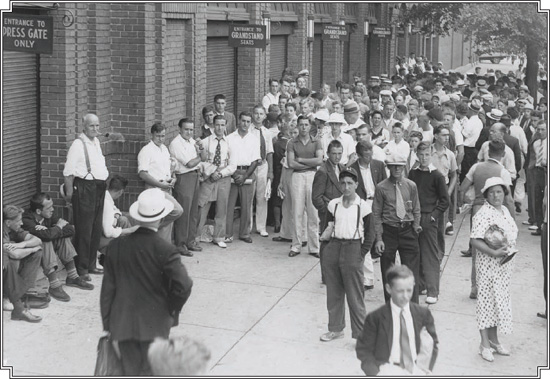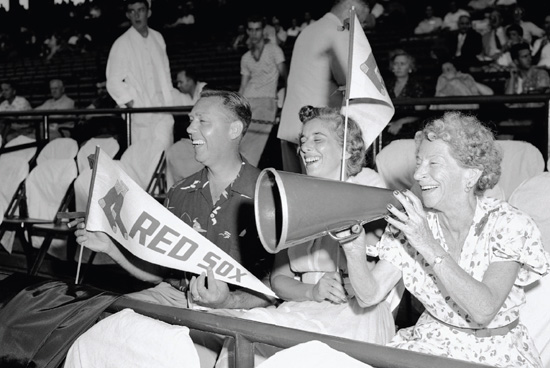Fenway Park (14 page)
Authors: John Powers

A Red Sox-Yankees doubleheader brought an early-morning crowd to Fenway on August 12, 1937.
A
s the thirties began, the Depression in the Fens already had been underway for a decade. Defeated and dispirited after three dreary years in the league basement, the skipper, who’d been used to pennants flapping during his days as player-manager, threw up his hands. “After handling three tailenders Bill Carrigan decided that he would not try again to start the Red Sox on an upward journey,” Mel Webb wrote in the
Globe
.
That task fell to Charles “Heinie” Wagner, Carrigan’s assistant and former teammate who’d seen enough of his players to be realistic. “All we need is a little quiet discipline and a little time,” he said after inheriting the job just before Christmas of 1929. “You can’t bring a ball team up to the top in a minute.”
It should have been an omen when President Herbert Hoover threw out the first pitch for Boston’s initial game at Washington and bounced the ball. Before the next day’s home opener against the Senators, which the Sox dropped by a 6-1 count before 7,500 chilled fans, Wagner was presented with an enormous floral horseshoe that required three men to shoulder to the plate.
It was intended as a good luck gesture, but it might as well have been a funeral wreath as his club was all but buried by Memorial Day, falling back into the cellar after dropping 14 straight games. The most fortunate man on the premises was pitcher Charles “Red” Ruffing, who’d led the league in losses for two years. He was dealt to the Yankees that spring and went on to earn a half-dozen World Series rings and make the Hall of Fame.
Despite 102 losses and a sixth consecutive last-place finish, owner Bob Quinn was ebullient about his club’s chances for 1931 under new skipper John “Shano” Collins, a Charlestown native who’d already been knocked around enough for a lifetime. He’d been named the victim in the case against the Chicago Black Sox, eight of whom were accused of conspiring to throw the 1919 World Series, which cost Collins $1,784 according to court documents, and then he had been traded to Boston just in time for the Sox downward spiral.
So even though the Red Sox were at the bottom of the standings and 41 games out at the beginning of the Labor Day weekend, Collins was optimistic. “I am confident that some other club will finish in last place,” he predicted before his men dropped a doubleheader on September 4 to the
Athletics. By then the only bit of suspense was whether Earl Webb would break the record for most doubles in a season.
Webb, who’d mined coal before he made the majors, was a journeyman outfielder whose erratic glove cost his team nearly as many two-baggers as he produced. But he banged out 67 doubles that year with only three triples while knocking in 103 runs and hitting .333. Though Webb was suspected of deliberately holding up at second, Collins said that “The Earl of Doublin” simply was “too darned slow on the bases to get to third.”
The Sox managed to crawl upward to sixth place, their best finish in a decade. But by the middle of the 1932 season Collins had concluded that they were past the point of mending and quit on June 19. “I have worked unusually hard with the Red Sox,” he said. “I have learned, however, that I was more or less on a treadmill and not going any place in particular.”
So Quinn tapped infielder Marty McManus to take over what he deemed “the most thoroughly demoralized ball club that ever existed.” Quinn, who’d been struggling financially even before the Depression, was demoralized as well. His club soon fell back to last place and ended up a whopping 64 games behind the Yankees after losing 111 games, the most in franchise history. Attendance plunged by half to 182,000, roughly a third of what the Braves were drawing on Commonwealth Avenue.
What Quinn needed was either a savior or a sucker who would take the club off his hands for a price, as he put it. The man was Thomas Austin Yawkey, a 30-year-old Yale grad who’d just inherited a fortune from his family’s lumber and mining interests. On February 25, four days after his birthday, Yawkey purchased both Fenway Park and the Sox for $1.2 million. Tom’s uncle and adoptive father, Bill Yawkey, had owned the Detroit Tigers from 1903 to 1919 and saw them win pennants in 1907, 1908, and 1909. Tom, who had the same aspirations, immediately began a refurbishment of both the park and the club. “Painters, plasterers and carpenters were scattered about the plant and soon everything will be in order,” the
Globe
reported a few days before the 1933 opening game of a city series with the Braves on April 8 (which the Sox won, 7-0).
Yawkey’s first priority was expanding the bleachers, where he believed the real fans congregated. “I may be mistaken but I think the grandstand fan is a casual—he comes to the game in much the same mood and manner that the theatre-goer goes to a popular hit,” he said. Renovating the roster was a more daunting challenge, but Yawkey was quick to start upgrading the Sox from 500-1 long shots to contenders, paying top dollar and over-thetop dollar for anyone he could grab.
SUNDAYS IN THE PARK
The legendary Massachusetts Blue Laws, which set aside Sunday as a day of worship and rest, prohibited Boston’s professional baseball teams from hosting Sunday home games from their very beginnings. Boston was not alone in banning Sunday baseball, but by 1918, all but three American League cities—Boston, Baltimore, and Philadelphia—had allowed it. The state law was amended in 1929 to allow for Sunday baseball, but the Red Sox were still stymied from playing at Fenway Park because of its proximity to a church. They played their Sunday contests at Braves Field for the next few seasons, until they caught a break from legislators.
In May 1932, the Massachusetts House of Representatives sponsored a bill that would loosen the restriction and allow the Sox to play at Fenway on Sundays. Specifically, the bill would lower the required church buffer zone from 1,000 feet to 700 feet, and the Church of the Disciples, at Jersey and Peterborough Streets, was about 850 feet away from Fenway. The church raised no objection, and the bill passed the state Senate on May 19, 1932. The Sox hosted their first Sunday game at Fenway on July 3.
If they were hoping to come out winners in their first-ever Fenway game on the Sabbath, the Sox might have chosen a more fortuitous season and a less daunting foe than the Bronx Bombers. In a game that took only 2 hours and 28 minutes to complete before a crowd of 7,000, the Yankees trounced the Sox, 13-2. As a result, the Yankees improved their 1932 record to 50-21, while the Red Sox were comfortably settled in last place at 14-57. Boston would go on to finish 43-111 that season, their worst record ever—64 games behind first-place New York.
The headline of the story said: “Ten Hits in Sixth, in which 14 Hostiles Go to Bat, Convert Game into Parade.” Dave “the Colonel” Egan, the
Globe
baseball writer, wrote that the nine-run Yankee inning was filled with “carnage and sabotage and rioting.”
Egan went on to write, “Ivy Paul Andrews, late of the Yankees, was the unfortunate youth upon whom the wrath of the New Yor-curs fell. He seen his duty and done it noble for the first five innings, but when the smoke of battle had cleared in the sixth, nine runs had been scored, the Messrs Andrews and Pete Jablonowski were weeping on each other’s shoulders in the showers, and Bob Kline was pitching and ducking.
“In that sordid sixth, 14 of the visitors paraded to the plate, assumed a battling posture, and collected 10 hits, thus reaching a new high for the year and convincing the experts that the Depression is over. And George Pipgras upset all the fine traditions of the pitching industry by making two singles in that one stretch. There should be a law against it.”


LADY WITH A MEGAPHONE
Mrs. Lillian Hopkins was known to thousands of Red Sox fans and players simply as “Lolly.” A lifelong resident of Providence, she was awarded a lifetime pass to Fenway Park as the team’s No. 1 fan. She made the 100-mile round-trip hundreds of times over 27 seasons between 1932 and shortly before her death in September 1959 at age 69.
Lolly occupied Seat 24 in Row 1 of Section 14, and she always came to Fenway with a megaphone and a scorebook. Many fans never met her but recognized her voice as she hollered advice and encouragement to players, managers, and umpires. According to a 1959 feature story in the
Globe
, “Lolly had become a baseball expert through the years and never hesitated to prove it. Many have felt the good-natured wrath with which she would set them straight.”
One woman asked in 1958, “Why doesn’t she go over to third base, so Williams can hear her better?”
“It’s habit, a habit I developed when I was a little girl and my father used to bring me up from Providence to see games at the Walpole Street and Huntington Avenue Grounds,” Lolly explained. “I always tried to get seats in that section if possible.”
The late Smoky Kelleher, a sports official and a Red Sox fan to rival Lolly in loyalty, used to sit in a box in front of her, where he became accustomed to her hollering. One day in 1938, he gave her a megaphone, telling her it would save her voice. Lolly hollered as loud as ever; the megaphone merely multiplied her range.
Today, Lolly’s passion for the Red Sox is preserved in the Baseball Hall of Fame. A life-size figure of her, megaphone and all, is front and center in an exhibit of some of the game’s most beloved fans.
His biggest blockbuster came shortly before Christmas of 1933 when he dispatched two players and $120,000 to the penniless Athletics for pitchers Lefty Grove and Rube Walberg and second baseman Max Bishop. “Yawkey appears to be Boston baseball Santa,” a
Globe
headline declared. “Has quite an array of Sox to hang up for local fans.”
Yawkey had more than enough cash to fund his horse-hide hobby. He owned a massive South Carolina plantation, a New York apartment, and soon acquired a suite at the Ritz in Boston. He also supplied fare for the Yuletide groaning board, sending up duck, quail, and venison that he and a few of his new Sox employees had shot during a hunting trip on his land.
There would be a new manager as well. Though McManus had nudged the Sox up from the cellar, Yawkey and new Sox General Manager Eddie Collins, the future Hall of Famer who’d been one of Yawkey’s boyhood heroes at the Irving School in New York, wanted a bigger presence. “If we could find a second edition of Connie Mack, that would be our idea of the perfect manager,” Collins remarked.